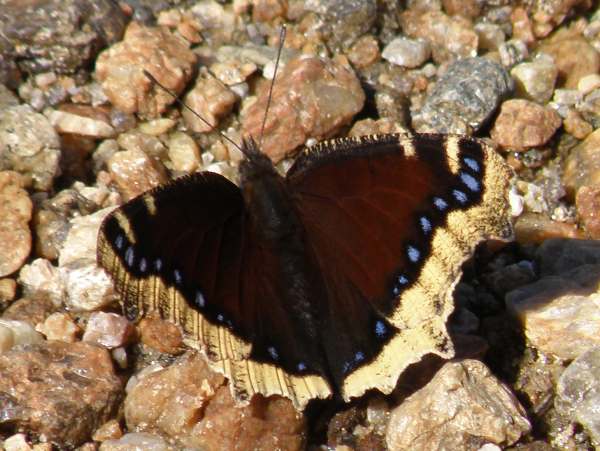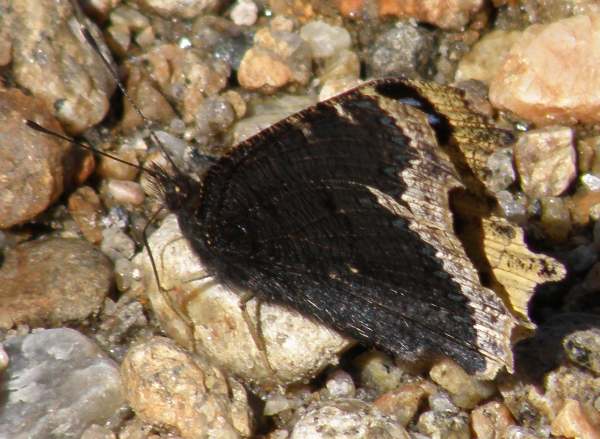Trees Birds Mammals Fish Amphibians Reptiles
Wild Algarve
Bookshop
Camberwell Beauty or Mourning Cloak Butterfly - Nymphalis antiopa
Phylum: Arthropoda - Class: Insecta - Order: Lepidoptera - Family: Nymphalidae

We saw our first Mourning Cloak butterfly beside the Madison River in Montana. It has special significance there because in 2001 the Montana designated the Mourning Cloak as its official state butterfly.
This lovely butterfly is often the first to appear in springtime the 'Wild West' states of America, where it is sometimes seen flying over the last of the winter snow.

On the other side of the Atlantic, in Europe the very same butterfly appears, although localised, in some countries vas breeding populations and in many more countries as a migrant. In Britain Nymphalis antiopa goes by the common name of Camberwell Beauty, named after the location of its first recorded sighting in England in 1748. In some years the Camberwell Beauty is seen all across Britain, but it is invariably most abundant in the south-east of England. Because this species mates only after hibernating as a winged adult, however, there are no British breeding colonies.
The dark purple-brown upperwings are bordered by iridescent blue spots within a broad cream margin, making this one of the most recognisable of all butterflies. The large wingspan - 6 to 10cm - also helps to make this butterfly hard to miss.
Like other dark-winged velvety butterflies, the Mourning Cloak's open wings absorb heat from the sunlight, and as a result it can fly even in the cool morning air. The habit of resting on south-facing sides of tree trunks with wings held open makes this a relatively easy butterfly to photograph.
Distribution
In North America this butterfly occurs everywhere from the edge of the tundra belt southwards to central New Mexico; it is not reported from the Caribbean and is rarely seen in the peninsular region of Florida.
Breeding populations occur in Scandinavia and across central mainland Europe, but not in Britain or Ireland.
Lifecycle
The Camberwell Beauty is single brooded both in Europe and in America. In Britain the first sightings are usually in July, and these lovely butterflies continue to arrive from the continent through August and September, with a few individuals being seen as early as the end of January or early February and as late as the beginning of December in years when the winter weather is unusually mild.
Overwintering as winged adults, these butterflies mate in springtime. In the USA they are reported to aestivate after mating and can live as winged adults for up to ten months. Once they awaken in the autumn (fall) they feed mainly on tree sap and to a lesser extent on rotting fruit. Unlike most butterflies in the family Nymphalidae, only occasionally do they take nectar from flowers.
Females lay their eggs in groups around small twigs on the larval foodplants, which in both the USA and Europe are various hardwood trees including riverside willows as well as elms, birches and poplars. The caterpillars, up to 5cm long when mature, are velvety black with raised white dots and rows of red spots and spines down the middle of their backs. When first hatched, the caterpillars make communal webs and feed together on leaves of their foodplants, but as they near maturity the caterpillars forage separately before pupating, a process that lasts about three weeks before the winged adults emerge.
Studying butterflies and moths...
Excited by rivers and streams? So are we, and we're pretty sure you would find the Winding River Mystery trilogy of action-packed thrillers gripping reading too. Dead Drift, Dead Cert, and Dead End are Pat O'Reilly's latest river-based novels, and now they are available in ebook format. Full details on our website here...
Buy each volume in ebook format for only £2.47 on Amazon... Paperbacks also available on Amazon at £6.95 each. All proceeds go towards keeping the First Nature website online.
Please Help Us: If you have found this information interesting and useful, please consider helping to keep First Nature online by making a small donation towards the web hosting and internet costs.
Any donations over and above the essential running costs will help support the conservation work of Plantlife, the Rivers Trust and charitable botanic gardens - as do author royalties and publisher proceeds from books by Pat and Sue.